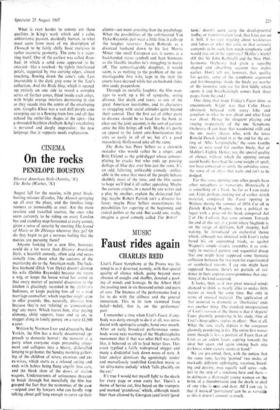Faust rides again
MUSIC CHARLES REID
Liszt's Faust Symphony at the Proms was lis- tened to as it deserved, namely, with that special quality of silence which, going beyond mere absence of coughs and shuffles, denoted a pool- ing of minds and homage. In the Albert Hall the pooling took in six thousand minds and pairs of ears. The fineness of the performance had a lot to do with the stillness and the general immersion. This in its turn stemmed from belief—belief, that is, on the performers' part.
I remember a time when Liszt's Faust, if any- body was dotty enough to do it at all, was intro- duced with apologetic coughs, hand over mouth. After an early broadcast performance some- body wrote next morning of the Mephistopheles movement that if that was what Hell was really like, it behoved us all to lead better lives. This crack typified a fairly widespread snigger and many a disdainful look down noses of note. A later analyst dismisses the agonisingly tender and marvellously tendrilled Gretchen music as 'an ultra-naive melody' which 'falls placidly on the ear.'
It's true I would not myself fight to the death for every page or even every bar. There's a theme of heroic cut, first heard on the trumpets and marked `grandioso,' which, although much finer than allowed by Georgian (and later) 'good
. taste,' doesn't quite carry the developmental traffic, or transformation load, that Liszt put on it. Still, if %se start niggling about weaknesses and lapses or Ns hat this critic or that seriously contends to be such, how much symphonic stuff would stay on in the repertory? Mahler's Sixth?
(Of this Sir John Barbirolli and the New Phil- harmonia Orchestra had given a superbly shaped and absorbing account two nights earlier. Don't tell me. however, that, quality for quality, some of the symphonic argument and fist-thumpings inside the finale are worthy of the immense tune-arc for first fiddle which opens it and breathtakingly comes back three pages from the end.)
One thing that made Friday's Faust shine so uncommonly bright was that Colin Davis
obviously believed with every lobe and
ganglion in Mut he was about and what Liszt was about. Hence the eloquent playing and singing respecikely of the BBC Symphony
Orchestra (I can hear that woodwind still) and the am men's chorus who, with the tenor Ronald Dowd, joined in at the end for the set- ting of 'Alles Vereiingliche,' the same Goethe lines as were used for another finale, that of
Mahler's Eighth. Hence, too, the special quality
of silence, without which the opening unison could hardly have had the same weight of spirit,
nor have convey ed so surely the subsiding sense, the sense of an ally ss that waits and isn't to be dodged.
For this same opening tune other people have other metaphors or transcripts. Historically it
Is something of a freak. So far as I can make out, Liszt, perhaps making use of earlier sketch material, composed the Faust opening in Weimar during the summer of 1854. Cut off in Zurich Richard Wagner, then a political re- fugee with a price on his head, composed Act 2 of The Valkyrie that same autumn. Towards the end of this act, at a point where Sieglinde is on the verge of delirium, half sleeping, half waking, he introduced an orchestral theme which, although not identical with Liszt's (who based his on augmented triads, as against Wagner's simple triads), resembles it so strik- ingly in metrical pattern and sequential droop that one might have supposed some thematic collusion between the two men for experimental or symbolical reasons. I say one might have supposed because there's no particle of evi- dence in their copious correspondence that any- thing of the kind occurred.
It looks, then, as if two great musical minds chanced to think as nearly alike as makes little matter at much the same time. But only in terms of musical material. The application of that material to dramatic or 'illustrative' ends was another thing. The standard interpretation of Liszt's version of the theme is that it 'depicts' Faust gloomily pondering in his study. One of Liszt's biographers replies in effect : 'Not at all. What the tune really depicts is the composer gloomily pondering in his. The entire first move- ment though is less a portrait of Faust than of Liszt as an ardent lover, aspiring towards the ideal but again and again. sinking back into darkness when victory seems at hand.'
We are presented, then, with the notion that the same tune, having 'painted' two males of markedly different upbringing, vocation, breed- ing and destiny, may equally well serve—sub- ject to the snip of a semitone here and there- to delineate a distraught young woman on the brink of a thunderstorm and the death in duel of one who is near and dear. All I can say is that if musical 'portraiture' can be as versatile as this it doesn't amount to much.






























 Previous page
Previous page